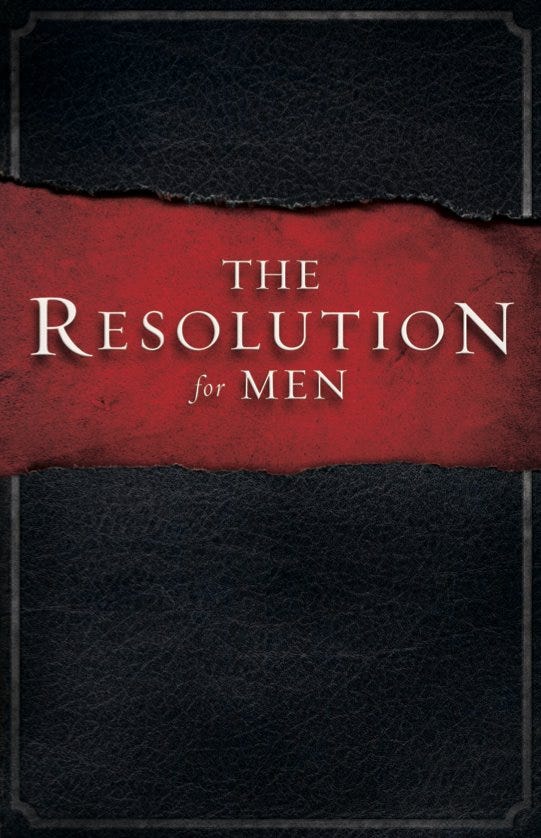Who Is a Man?
A Review of "The Resolution for Men" by Stephen & Alex Kendrick with Randy Alcorn (edited by Lawrence Kimbrough)
Kendrick, Stephen & Alex, and Randy Alcorn. The Resolution for Men. Edited by Lawrence Kimbrough. Nashville, Tennesse: B&H Publishing Group, 2011.
Dear Fellow,
I hope this finds you in good shape. Since the first day of this month, a lot has happened here (Nigeria). The umbrella issue is a nationwide protest by citizens, which ends today based on the notice of the organisers. There have been reports of looting and deaths, among other sad tales and reports. State governments set curfews to manage the situation. Desperate times we live in. I pray you do not lose your wonder amidst all this.
The Backstory
I mostly write reviews of books I am done reading. And so, this review is yet another exception. I have finished reading more than a dozen this year (so far), but I could not resist this one coming up as the subject of today’s despatch: The Resolution for Men, a result of combined efforts between Stephen Kendrick, Alex Kendrick, and Randy Alcorn as authors, and Lawrence Kimbrough as editor. I think this choice was strengthened by Daniel Cox’s book announcement on Amecian Storylines on Thursday, 8th August 2024. Cox’s forthcoming book Uncoupled being the subject of that post, he wrote:
“The gender gap continues to garner a lot of interest, but the story I want to tell is about so much more than politics. It’s about the degradation of male-female relationships. Marriage rates are down. So too is dating. Rates of anxiety are worryingly high among young men, and young men appear more isolated and alone than ever. Both young men and women feel more unsure about their place in society and increasingly comfortable in blaming each other.”
The paragraphs that follow that excerpt highlight some of the issues on the part of men, which were addressed in the book under review.

The Reading
Having painted the condition of especially familial relationships in the world today, the book paints a picture of today’s men, thus:
“This current generation of young men doesn’t know what it means to be a man. Or to be a mature, responsible leader. Or to be a strong and engaged father one day. Society is guiding boys to remain boys as long as possible—extending childhood into their thirties—while forcing girls to become women long before they are ready.”
“Instead of growing up, getting married, and courageously raising up the next generation, millions of young men are staying single, remaining emotionally and directionally dependent on their mothers while becoming addicted to entertainment, pornography, and video games. They want privileges and rewards of manhood but only the responsibilities and moral requirements of boys. So when they become fathers themselves, they don’t know what to do, and they feel extremely ill-equipped.”
There you have it—a portrait of where we are today as a society. The book, primarily written for husbands, provides enough room for unmarried men, its first part describes the issues. The second part paves the way forward to break free from the strongholds of the reader’s yesterday, and shows how to be victorious today, and into the future. The appendices comprise relevant resources such as a piece entitled “How Can I Find Peace with God?” and also the “Final Speech from Courageous”, which is the movie the book was based upon.
I see the need to thoroughly seek answers to the question “Who is a man?” and live by the truth uncovered.
The Lessons
Although I am not done reading the book, the excerpt in the previous section reveals two areas demanding immediate attention in my becoming a man. The first is ignorance of responsibility: “This current generation of young men doesn’t know what it means to be a man.” I see the need to thoroughly seek answers to the question “Who is a man?” and live by the truth uncovered. Thankfully, the book gives access to a chunk of that truth. The rest I must relentlessly seek and live by for the rest of my days.
The second area demanding immediate attention in my becoming is discipleship: “[This current generation of men] want privileges and rewards of manhood but only the responsibilities and moral requirements of boys. So when they become fathers themselves, they don’t know what to do, and they feel extremely ill-equipped.” Again, thankfully, this book comprehensively addresses the issue of discipleship. That is the key framework for the restoration of true manhood that the authors put forward, as the first paragraph of the Introduction reveals: “This book is an unapologetic call for men to live courageously for their faith and their families. It is designed to strategically challenge you to become the man God created you to be.”
And I must confess my gratitude here: I am blessed by so-helped-by-God a dozen men, foremost my father. Thus, I cannot say that I lack models. By God, I will live up to my purpose as a man.
The Conclusion
A problem of a generation, based on human history, is often settled by the resolve of one man (or woman). Mid-twentieth century America had Martin Luther King Jr. (1929–1968), and South Africa in the same era had Nelson Mandela (1918–2013). It is upon me—and my friends—to relentlessly pursue becoming the kind of man God desires, to and for my family and beyond. By grace through Christ Jesus, amen.
May you fully become, good Fellow.
Your LetterMan,
Tongjal, W. N.

